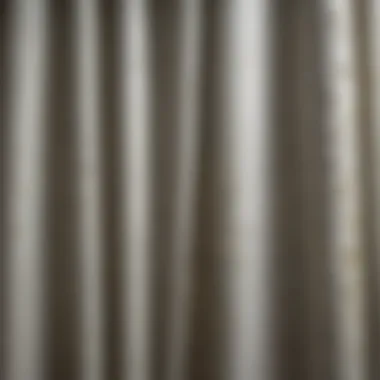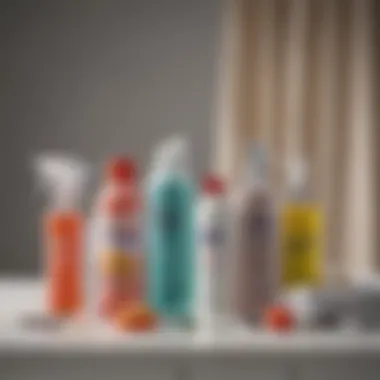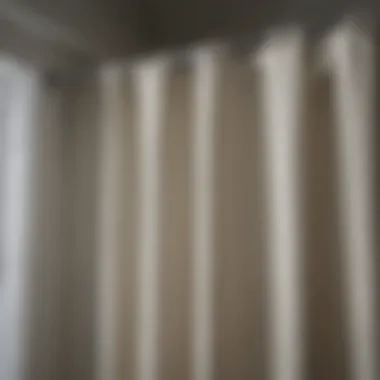A Complete Guide to Cleaning Moldy Shower Curtains


Intro
Cleaning moldy shower curtains is an essential household task that often gets overlooked. Fortunately, it is within reach for anyone who wants to maintain a clean bathroom environment. Mold growth not only detracts from the aesthetic of a bathroom, but it can also pose health risks due to allergic reactions and respiratory issues. Understanding the causes of mold growth helps in finding effective cleaning strategies. This guide aims to provide straightforward methods to clean various types of curtains efficiently, covering preparation, cleaning, and preventative measures to ensure freshness.
Causes of Mold Growth
Moisture and warmth are prime conditions for mold development. Shower curtains frequently absorb water during showers, creating a breeding ground for mold particles. Poor ventilation in bathrooms only aggravates this condition. It is important to address these conditions to both clean current mold and prevent future occurrences. Recognizing factors like humidity levels and curtain material can aid in choosing the right cleaning methods behind mold removal.
Key Points to Discuss
Throughout this article, we will explores topics such as:
- Identifying cleaning options based on curtain material (e.g. vinyl, fabric, and plastic)
- Deep cleaning versus regular maintenance techniques
- Seasonal cleaning schedules for better upkeep
- Budget-friendly solutions using household products
Crafting a plan against mold leads to a healthier living space. By addressing both the cleaning and preventative aspects, we can extend the lifespan of shower curtains and avoid the hassle of recurring issues.
Preamble to Shower Curtain Maintenance
Maintaining shower curtains is a crucial yet often overlooked aspect of household care. Shower curtains serve a functional purpose but also contribute to the overall aesthetic of a bathroom. This section emphasizes the importance of regular maintenance to ensure your shower curtains remain clean and appealing.
Importance of Clean Shower Curtains
Clean shower curtains significantly enhance the hygiene and ambiance of a bathroom. They prevent the accumulation of dirt, soap scum, and, most importantly, mold. Mold spores thrive in warm, damp environments, making bathrooms an ideal breeding ground.
Regularly cleaning your shower curtain helps improve indoor air quality as it reduces allergens and prevents odors. Rather than having aged and stained curtains, a clean and fresh curtain elevates the entire bathroom space. When replacing curtains becomes necessary, it is usually more economical. Spending a short amount of time on upkeep not only saves money but also extends the life of the curtain itself.
The Problem of Mold Growth
Mold is a persistent problem for many households. It not only affects the visual appeal but is also harmful to health. Mold can actually contribute to breathing issues and allergic reactions. When left unattended, it can spread rapidly, embedding itself into the fabric or vinyl of the curtain.
Some factors contribute to mold growth. High humidity levels in bathrooms, combined with inadequate ventilation, create a perfect environment for mold spores to flourish. Another contributing issue is the frequency with which the curtain gets wet without proper drying in between uses. This is why proper cleaning is critical.
The consequences go beyond mere aesthetics. If mold begins to proliferate, you can notice increased respiratory problems, as spores can become airborne if disturbed. These hidden health risks make it imperative to understand how to prevent and handle mold growth effectively.
Overall, taking time to maintain your shower curtain through cleaning and inspection is essential for health, savings, and an aesthetically pleasing home. Understanding both the importance and risks involved clarifies why routines in shower curtain maintenance ought to be prioritized.
Materials Used in Shower Curtains
Understanding the materials used in shower curtains is crucial for selecting the right one for your bathroom and keeping it clean. The material influences not only the curtain's appearance but also its longevity, maintenance requirements, and resistance to mold growth. This section examines three common types: vinyl, fabric, and plastic. By making an informed choice, you ensure the curtain supplements your bathroom's aesthetic while minimizing the hassle of mold accumulation.
Vinyl Shower Curtains
Vinyl shower curtains are a popular choice due to their affordability and waterproof properties. They create a barrier against water, keeping your bathroom dry. Vinyl curtains are easy to wipe down if they become soiled, and they often come in a variety of colors and patterns. However, they can attract mold if not cleaned regularly.
One consideration is the potential for vinyl to emit volatile organic compounds, which can affect indoor air quality. To mitigate this, ensuring proper ventilation in your bathroom is essential. When it does come to cleaning mold off vinyl, using warm soapy water or a mixture of vinegar and water can be effective.
Fabric Shower Curtains
Fabric shower curtains, made from cotton or polyester blends, offer a softer look and feel. Unlike vinyl, they are often machine washable, making them a convenient option for regular cleaning. Despite their aesthetic appeal, fabric curtains require more diligence concerning maintenance. They are prone to absorb moisture, which can lead to mold growth if they stay damp for extended periods.


When selecting fabric curtains, opt for ones treated with a water-resistant finish. This may offer some barrier against mold. For cleaning, regular washing in hot water is usually effective. Adding a little vinegar to the wash can further help combat any emerging issues with mold growth.
Plastic Shower Curtains
Plastic shower curtains made from polyethylene or other similar materials also serve as effective water barriers. They are generally lightweight and budget-friendly. Like vinyl, plastic attracts dampness and therefore has a risk for mold growth. Typically, these types of curtains require simple upkeep to maintain their appearance.
For cleaning, a mixture of baking soda and water to scrub the curtain can swiftly address mold. Removing the curtain periodically for rinsing is also useful. Though they don’t require as much attention as fabric curtains, ensuring your bathroom's overall environment is conducive to drying is crucial in prolonging the curtain's life.
Identifying Mold on Shower Curtains
Recognizing the presence of mold on your shower curtains is essential for maintaining a clean and healthy bathroom. Mold can compromise both hygiene and aesthetics, making it vital to identify any growth as early as possible. Prompt action can prevent mold from continuing to spread and safeguard public health. Regular inspection of your curtains should be integrated into your maintenance routine, ensuring that you observe not only the visible signs but also heed any indicators that might alert you to underlying issues.
Visual Signs of Mold Growth
Mold often first appears as dark spots or patches, which can be mistaken for soap scum or dirt. It can come in various colours, mainly black, green, or white. When the growth is still in its early stages, the spots are small and usually develop in moist and warm areas, including the areas along edges and close to the curtain rings.
Typical signs include:
- Discolouration: The fabric may appear uneven or marked.
- Raised or textured surfaces: Some mold strains may create a fuzzy appearance.
- Stains: Watermarks or smudges around areas can also signal mold presence.
It is important to know that mold can grow not only on the visible areas but also behind the curtain if there is a lack of washing or exposure to humid conditions. Regular inspection covers both sides of the curtain to effectively identify any emerging mold.
Smell as an Indicator
Sometimes, mold may not be visible right away. The sense of smell can be a powerful additional cue. If there's a musty, earthy odour in your bathroom, even with no clear visual signs, then it indicates possible mold presence. This smell arises because of the release of volatile organic compounds produced by mold during growth.
Key points to consider:
- Noticing sudden odour changes: If your bathroom gains an unpleasant smell that wasn't there before, consider checking your shower curtain.
- Addressing humid spaces: High humidity may worsen the smell, reinforcing the need for good ventilation and monitoring over time.
Preventative Measures
Taking preventative measures is crucial to maintain the hygiene and appearance of shower curtains. Mold growth not only affects aesthetics but also poses health risks. Regular care can save time and effort in the long run. Knowing how to prevent mold in the first place reduces the need for extensive cleaning later and enhances the overall environment of your bathroom.
Choosing the Right Curtain Material
When selecting a shower curtain, the material plays an essential role in mold prevention. Vinyl curtains tend to repel moisture better than fabric. They are often easier to clean and dry faster, which helps reduce mold growth. However, they can be less breathable. On the other hand, fabric curtains offer better aesthetics but require careful maintenance and more frequent washing.
- Consider several factors when choosing shower curtain material:
- Moisture absorption rates
- Ease of cleaning
- Durability
- Aesthetic appeal
Plastic shower curtains are also an option, offering a lighter experience. Gauge their weight, as thicker plastic can often withstand moisture better compared to thinner options, reducing delicate wear. Making an informed choice can drastically minimize mold issue.
Ventilation in Bathrooms
Proper ventilation is important in freventing mold growth. Humidity often spikes during showers; therefore maintaining good air flow helps. Options for increasing ventilation include installing exhaust fans or keeping windows open.
- Here are some approaches to improve ventilation:
- After showers, leave the bathroom door open to allow steam to escape.
- Consider adding a dehumidifier where mold is problematic.
- Regularly check vents to ensure they are clear of obstructions.


Ventilation consistently reduces humidity levels and subsequently decreases the chances for mold to develop. Adequate airflow prevents dampness from lingering on surfaces, including curtains.
Regular Cleaning Schedule
Having a regular cleaning schedule for your shower curtains simplifies maintenance and discourages mold. Even if mold does not appear immediately, cleaning keeps bacterial growth under control.
- Here’s a practical routine:
- Wash fabric curtains every 1-2 months.
- Wipe down vinyl or plastic curtains every couple weeks.
- Use preventive sprays which can be useful to coat surfaces resistant to mildew.
Cleaning according to a planned schedule does not leave room for negligence. When visible dirt comes from individual efforts it's easier to maintain clean curtains. Regular checks educates on any variations that could develop mold, taking timely action is critical.
Methods for Cleaning Moldy Shower Curtains
Cleaning moldy shower curtains is crucial for maintaining a unique bathroom atmosphere, while preventing health risks associated with mold exposure. Regular cleaning not only removes unsightly stains but also eliminates bacteria and allergens that could affect the inhabitants of the house. Thus, using appropriate methods for cleaning is essential for homeowners.
Hand Washing Techniques
Hand washing shower curtains may seem less efficient compared to using machines. However, this method offers precise control over the cleaning process. Begin by removing the curtain from the rod. Then, fill a bathtub or a large basin with warm water and a suitable cleaning solution—like vinegar or a mild detergent. Immerse the curtain fully in water and scrub gently with a sponge or a soft brush to prevent damage. Focus on heavily soiled areas, which often harbor more mold. After scrubbing, rinse with clean water to remove all residue—you want to avoid any soapy remnants.
Using a Washing Machine
While hand washing is valuable, machine washing can be a timesaver. Before placing the shower curtain in the washer, ensure that it is machine-safe by checking product labels. If it is fabric or resistant plastic, it generally qualifies. Adding towels during this cycle can help with effective washing by providing texture that aids in loosening dirt and mold. Select a gentle cycle with cold water to protect the fabric and materials. After completing the washing process, hang the curtain to dry thoroughly, as dampness may encourage further mold growth.
Effective Cleaning Solutions
Vinegar and Baking Soda
One of the most praised cleaning solutions involves mixing white vinegar with baking soda. This combination acts effectively against mold. Here’s why this solution works:
- Natural ingredients: Easily obtainable and gentle on most fabrics.
- Cleans well: Vinegar breaks down mold while baking soda adds abrasiveness suitable for scrubbing.
To apply, you can spray the mixture directly onto the moldy areas of the curtain. Allow it to sit for 10 to 15 minutes for maximum effect before rinsing. Nevertheless, while vinegar serves as a disinfectant, persistent stains may still require additional treatments.
Bleach Solutions
When severe mold problems arise, bleach becomes an option to consider due to its potent antimicrobial properties. This is particularly useful on white or light-colored fabrics where color fading is not an issue. The primary advantages include:
- Strong sterilization: Effectively eliminates most mold types.
- Prospective stain removal: Bleach can tackle tough stains inaccessible by other methods.
However, use caution: bleach can weaken and deteriorate some fabric fibers over time. Mixed bleach with water is generally the effective approach, using a ratio of 1 cup of bleach per gallon of water. Apply, scrub lightly and rinse thoroughly.
Commercial Cleaners
For those who prefer convenience, commercial cleaning products are available. These cleaners are specifically designed for removing mold from a variety of materials and often work with minimal preparation required from the user.
- Targeted cleaning properties: Formulated with precise ingredients for effective results.
- User-friendly: Comes ready-to-use, saving time on preparation.
Notably, while these products simplify the task, check their compatibility with specific materials to avoid damage. Besides, it's advised to follow instructions on the label for safe application.
Regular maintenance and appropriate cleaning techniques can keep your shower curtains mold-free efficiently, ensuring a cleaner and healthier environment.


Drying and Storing Shower Curtains
Drying and storing shower curtains effectively is crucial to maintaining their lifespan and preventing mold reappearance. Proper drying techniques significantly minimize residual moisture, reducing the risk of mold growth between washes. Storing curtains correctly ensures they remain clean and functional whenever they are needed again.
Proper Drying Techniques
After cleaning a shower curtain, it is essential to dry it properly. Accumulated moisture can linger in the fabric or material, creating a perfect breeding ground for mold. Here are several techniques to ensure an effective drying process:
- Air Drying: One of the most effective methods is to hang the curtain in an open space to allow air circulation. It is best to avoid direct sunlight as it can deteriorate some materials, especially delicate fabric.
- Machine Drying: If the care label allows, a tumble dryer on a low heat setting can speed up the drying process. Using dryer balls can help to keep the curtain moving, allowing even heat distribution.
- Use of a Fan: Placing a fan near the curtain can help expedite drying. Positioning it strategically can create a constant airflow that helps moisture evaporate quickly.
- Bathroom Ventilation: Utilizing bathroom vents or keeping windows open while drying can also decrease humidity and facilitate quicker drying.
Storing When Not in Use
The way a shower curtain is stored plays a significant role in its condition when it is reused. Proper storage helps avoid wrinkles, dust accumulation, and moisture retention:
- Fold or Roll: Depending on the material, curtains can either be folded neatly or rolled without creating pressure points. This helps in maintaining their shape.
- Use Storage Bags: If possible, use breathable storage bags to keep curtains protected during periods of disuse. Avoid plastic bags as they can trap moisture and promote mildew growth.
- Regular Checks: Anytime you take out the curtain to use or utilize bathroom space, do a quick check to ensure no dampness or mold formation exists.
Using the right drying and storing practices can significantly contribute to the overall health and cleanliness of your bathroom environment. Consistency in these habits introduces a heightened sense of hygiene and pride regarding household maintenance.
Maintaining sensitivity towards the proper care of shower curtains is essential, not just for the material integrity, but also for personal health and comfort.
Ongoing Maintenance Practices
Maintaining shower curtains is crucial for achieving a consistently fresh and clean bathroom environment. Without ongoing maintenance, the risk of mold accumulation significantly increases. Mold not only affects the visual appeal of shower curtains but also poses health risks, especially for individuals with respiratory issues. Implementing simple maintenance routines can mitigate these risks and prolong the lifespan of your shower curtains.
Routine Inspections
Regular inspections of shower curtains should be a fundamental practice. Inspecting allows you to catch potential mold growth early before it exacerbates. This is particularly important in humid environments where moisture availability leads to rapid mold proliferation.
When conducting an inspection, you can consider these steps:
- Frequency: Aim for inspections every couple of weeks.
- Focus Areas: Pay attention to corners and folds that may hold moisture.
- Check for Stains or Odors: Immediate detection of stains or warn odors can suggest mold growth.
Routine inspection includes observing not just the shower curtain, but also the area where it hangs. Ensure proper airflow by quickly adjusting any items nearby that block ventilation.
The benefit of inspections is that they require minimal effort but can have significant impacts. You may sometimes catch mold in its infancy, allowing for prompt and easy cleaning rather than an extensive process.
Prompt Cleaning After Mold Appearance
The phase of cleaning after discovering mold is critical. It cannot be emphasized enough how promptly addressing this situation can protect both health and property. Delaying treatment often leads to more expansive cleanup damage and a higher chance of spores spreading.
Take guidance from the following key points when tackling cleaning:
- Immediate Attention: The moment mold becomes visible, initiate cleaning.
- Select Appropriate Cleaning Solutions: Depending on the material of your shower curtain, certain solutions work better than others, like vinegar for fabric and fabric safe bleach for tougher stains.
- Follow Proper Guidelines: Consider the recommended methods specific for your curtain material mentioned in prior sections of this guide.
- Disposable Filters: If you had previously used filters in shower system areas that show mold, change them instantly to avoid re-contamination.
In times when severe mold is present covered with dark spots, know that immediate options such as soaking or using washing machines can be effective to subdue growth before it settles.
Epilogue
The significance of maintaining clean shower curtains cannot be understated. This article has highlighted several factors contributing to the need for proper care and how simple practices can greatly enhance the overall hygiene of your bathroom. An often overlooked aspect of home maintenance, mold-infested shower curtains can harm one’s health and create unpleasant environments.
- Improved Air Quality: A mold-free space reduces allergens and pathogens, contributing to a healthier home atmosphere.
- Longevity of Your Shower Curtains: Regular cleaning and maintenance can extend the life of your curtains, saving you money in the long run.
- Visual Appeal: Clean curtains enhance the overall aesthetics of your bathroom, presenting an organized and thoughtful living space.
Neglecting shower curtain maintenance leads to more significant issues as mold can quickly damage materials. It is essential to recognize when cleaning is necessary and act promptly. Last but not least, adopting a consistent cleaning routine, selecting appropriate materials, and ensuring proper ventilation are key strategies informed by this guide. Prioritizing these practices supports not only the functional aspects of your home but also contributes positively to personal well-being.
Keeping your shower curtains and the space around them clean is vital. Don’t delay taking action when mold symptoms emerge. Discover methods that work for your specific situation and remain diligent about upkeep.
In summary, prioritizing cleanliness leads to a healthier bathroom, reinforcing good habits for maintaining hygiene in other parts of your home.







